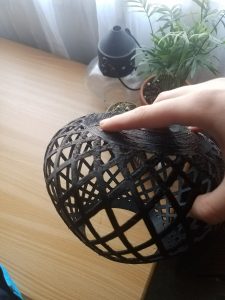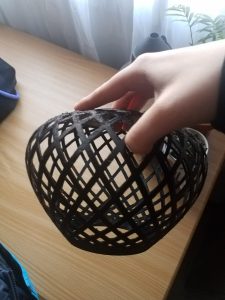This week, we printed our Fusion 360 models, heard from biohacker Dot Silverman, and was taught about UPS and 3D printing from Alan Amling.
I thought the UPS talk was very interesting – we are not yet part of a world where customized 3D printed parts are ordered regularly everywhere and by everyone. But UPS imagines a world where this can happen and has realized that, to obtain that future, we must start now.
During my sophomore year internship with Boeing, the engineering team I supported was working on producing certain tooling and equipment parts with a 3D printer. They didn’t need to be super strong – the just needed to be cheap and in large quantities. The team spent the entire summer getting the massive 3D printer up and running and conducting tests/printing prototypes. If we could have ordered from UPS’s on-demand manufacturing network, we would have had a lot more time to pursue other ventures or to perfect this one.
UPS has launched an on-demand manufacturing network that links its global logistics network with 3D printers at UPS stores. More on this can be found in a post by UPS here. As the 3D printing tech matures, it’s only natural that we start using that tech to disrupt the market in bigger ways.
Our next speaker, Dot Silverman, taught us about biohacking and how 3D printing can be one method used to biohack. Biohacking is known as “do it yourself biology”. It employs the maker mindset we’ve been learning about in class and is often used to teach and explore new and exciting facets of science. The PBS News Hour wrote an interesting article about biohacking here. I read one particularly helpful excerpt from it: “[Biohacking] takes place in small labs — mostly non-university — where all sorts of people get together to explore biology…It often is aimed at producing a product…It is experimenting on the cheap, usually without the benefit of a fancy university laboratory, and it often involves DNA and genes.”
I’ve found a website that contains biohacking lessons that can be taught in a school environment. BioHack Academy has courses on microbiology, electronics, biomaterials, and even 3D printing lessons like design and CAD!
Learning about biohacking has expanded my knowledge of the maker community and made me really excited for future students. Biohacking lends itself so well to education and makes biology fun and hands-on. Of course, Dot told us all about how bigger companies are starting to make bones and more potentially profitable products, but I really loved the smaller scale educational side of biohacking.
I’m excited to get into the Fablab and see what it has to offer. I am inspired by the lamp I was able to print out and want to learn how I can design more cool and useful things at the Fablab. The hanging lamp shade I made in Fusion 360 finished printing. It took around 11 hours! I learned how to resize it for the Ultimaker while making sure the openings were still the right size. I printed it without supports because Cura wanted to generate a support for every diagonal intersection (which would have been overboard). It printed out perfectly without any mistakes! I am very happy with it and can’t wait to take it home to use with the light fixture I have there.


My group went through several ideas and began to narrow down the ones that are realistic but still creative. We have a pretty long list of ideas that range from very technical to not at all. Many of them address different need groups. I think we still need a few more days to make a final decision, but I’m confident that all our options would yield an awesome project!

Aubrey,
That lampshade is wicked cool! I think one of the best things about 3D printing is how easy it has been for us to pick up and run with. Each print comes with its fair share of challenges, which become reduced with more and more practice printing. Just 6 weeks into the course, you have created a masterpiece lampshade, that truly looks like artwork. And we are only going to get better. Looking forward to seeing more of your prints in the future!
Hey Aubrey,
I also found the UPS presentation intriguing. Alan’s work is helping to bring us closer to the on-demand manufacturing world that you wrote about. I think your lampshade creation turned out really well. Does it fit your light well? Does it produce cool patterns? I would be interested in seeing its functionality in next week’s post.
Jason
Hi Aubrey,
I also thought that the presentation from UPS was very interesting and it got me to think about how this could potentially have global impacts. Imagine if you ordered something off of Amazon and instead of it being shipped from a warehouse, it would get printed at a UPS site and be shipped in a couple of hours. Not only would consumers get their products quicker, it would also vastly lower the cost of manufacturing and transportation and help reduce emissions in the process.